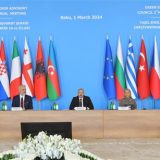The files we follow: China in the Indo-Pacific; China’s political and commercial involvement in Africa; Chinese military and Taiwan Strait; China and Eastern Europe…
GET YOUR SUBSCRIPTION FOR FREE!
– Chinese ships at Ream naval base in Cambodia
On December 3, two Chinese People’s Liberation Army (PLA) navy corvettes docked at the Ream naval base in Cambodia. Cambodian Defense Minister Tea Seiha reported that he had visited the Chinese vessels on the same day, accompanied by his father and predecessor Tea Banh. The following day, Tea Seiha welcomed the Vice-Chairman of the Chinese Central Military Commission (CMC), He Weidong, who was visiting Phnom Penh at the time (1).
The Khmer media also reported a “training session” organized by Chinese sailors for their Cambodian counterparts, while insisting, in line with the rhetoric repeated to this day, that the Ream base was being “repaired” by the Chinese side, and that Cambodia would never host a foreign naval base on its territory. Nevertheless, analysts who have long followed the expansion of the Ream shipyard – whose current capacities exceed the needs of the Cambodian navy, and are therefore clearly not exclusively intended for it – see this stopover as a discreet inauguration of the base. In other words, a mute confirmation of their assertions concerning the use China could make of it to refuel, repair and deploy its vessels more easily in the South China Sea, as well as in the Strait of Malacca.
– Seventh Sino-Russian strategic air patrol
On December 14, Chinese and Russian military aircraft crossed the South Korean and Japanese ADIZ (2). The Chinese force included two H6-K strategic bombers, escorted by two J-16 fighter jets; the Russians deployed two Tu-95MS bombers, escorted by two Su-35 fighter jets. The aircraft flew over the South China Sea, then crossed the Tsushima Strait into the Sea of Japan. Tokyo and Seoul, detecting an entry into their respective Air Defense Identification Zones (ADIZ), dispatched their own fighter jets to intercept them.
On the same day, the Russian and Chinese Ministries of Defense published a short notice explaining that this was the “seventh joint air patrol” involving the Russian and Chinese armies, and specifying that the maneuver had been carried out “in accordance with the annual cooperation plan” between them. Official Chinese media reported that the aircraft had “strictly respected international law” during their joint crossing. Similar patrols indeed have taken place once in 2019, 2020 and 2021, and twice in 2022. The last occurrence took place in June 2023.
The purpose of these patrols is not only to demonstrate Sino-Russian proximity, but also to serve as a reminder of the material capabilities of both armies – strategic bombers are capable of carrying nuclear-tipped missiles – and to reaffirm their right to fly over the area, in much the same way as American, Canadian, and sometimes even British and French ships cross the Taiwan Strait.
– Strengthening of Sino-Vietnamese cooperation
Chinese President Xi Jinping visited Vietnam from December 12 to 13 – his first state visit to Hanoi since 2017. He met his Vietnamese counterpart Vo Van Thuong, as well as Vietnamese Prime Minister Pham Minh Chinh and General Secretary of the Vietnamese Communist Party Nguyen Phu Trong. At the end of this historic visit, the leaders of the two countries jointly declared their desire to deepen cooperation, particularly in the fields of defense, intelligence, digital technology and telecommunications.
On the specific subject of defense, the joint declaration refers to “high-level exchanges” and “joint exercises” between the armies of the two countries. It also refers to enhanced cooperation in the fields of defense industry, “non-traditional security“, “border defense“, and maritime affairs, with increased exchanges between navies and coastguards.
However, despite the closeness of the two countries in military matters – with the mention, for example, of “direct lines [of communication] between defense ministries” – the absence of any concrete announcements in this area, as well as the absence of an authority directly in charge of the question, puts the scope of the declaration into question. All the more so as He Weidong, Vice-Chairman of the Central Military Commission – China’s highest defense body – recently visited Cambodia and Laos, but did not extend his diplomatic tour to Vietnam.
Although the Chinese media describe China and Vietnam as “brotherly” countries with similar political systems, they do have a painful bilateral history – having gone to war with each other in 1979. But in a context where China is making every effort to counter the US “small circle strategy” (3) aimed at encircling it, the display of a flourishing partnership serves to counterbalance the growing rapprochement between Washington and the other powers in the region – particularly with the Philippines since the election of Ferdinand Bongbong Marcos. The latter, more inclined to vehemence in defending his national interests (4), is more receptive than his predecessor to help from the American side – even if this means granting him the usufruct of naval bases on his territory.
(1) He Weidong seems to have been sent to replace the Chinese Defense Minister, who has still not been appointed since Li Shangfu’s disgrace in October 2023.
(2) ADIZ: “Aerial defense identification zone”. This is a zone delimited unilaterally by a country, within which it requires prior notification of aircraft – particularly military aircraft – wishing to cross. It differs from the air sovereignty zone, which is defined as the airspace above a country’s territory, extending up to 12 nautical miles beyond its coastline. It is therefore not illegal, under international law, to transit through it without notifying the country that determined the ADIZ.
(3) The “small circle strategy” refers to the US strategy of forming bilateral security partnerships in its neighborhood, or creating “minilateral” platforms involving a limited number of partners, such as Aukus, Five Eyes or Quad. China decries this practice as an attempt to contain it.
(4) These national interests include Philippine fishermen’s access to resources in the South China Sea, which is regularly obstructed by Chinese coastguard vessels. This maritime zone, bordered by China, the Philippines, Vietnam and Malaysia, is rich in fishery resources and is the subject of sovereignty disputes. Tensions have taken on an increasingly violent tone, with a collision between a Chinese coastguard vessel and a Philippine ship on December 10.






